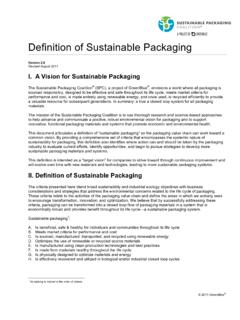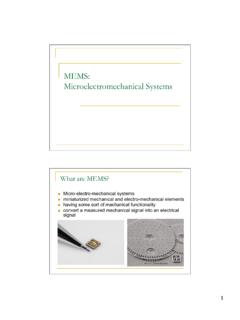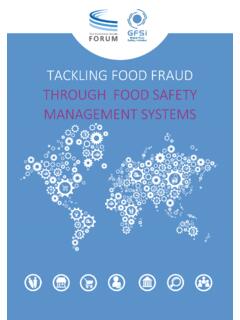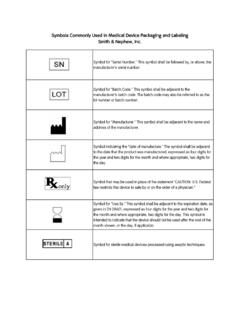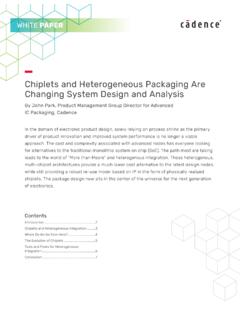Transcription of USP <665> Polymeric Components and Systems Used in the ...
1 USP <665> Polymeric Components and Systems Used in the Manufacturing of Drug ProductsBPSA International Single-Use Summit July 13, 2017, Washington, DCMichael N. Eakins , Member, USP packaging & Distribution Expert CommitteePrincipal Consultant, Eakins & Associates Scientific, independent, volunteer-driven, nonprofit organization Established in 1820 Headquartered in Rockville, MD Facilities in Africa, Brazil, China, India, Switzerland Set public quality standards for prescription and over-the-counter medicines, excipients (inactive ingredients), dietary supplements, and food ingredients Worked closely with FDA and predecessors for >100 years, developing and revising drug quality standards Translated into Chinese and Spanish Legally recognized in 39+ and standards used in 140+ countriesUnited States Pharmacopeia2 USP General Chapters Chapters <1> to <999> are enforceable in the USAUSP General Information Chapters Chapters <1000> to <1999> Chapters provide information they contain no standards, tests, assays, nor other mandatory specifications.
2 With respect to any Pharmacopeial articlesUSP General Chapters3<661> Plastic packaging Systems and Their Materials of Construction<1661>Evaluation of Plastic packaging Systems and their Materials of Construction with Respect to Their User Safety ImpactPlastic Components and packaging Materials < > Plastic Materials of Construction< > Plastic packaging Systems for Pharmaceutical Use< > Plastic Components and Systems Used in Pharmaceutical Manufacturing 4 Issued May 1, 2017 USP General Chapters: <659>, <661>, < >, < >Reason: Compliance Provides a three-year period for implementation of the requirements specified in General Chapters < > and < >, which otherwise will become applicable on May 1, 2017 through General Chapter <659> Reinstates requirements previously expressed in General Chapter <661> during this three-year period Enables early adoption of the requirements in General Chapters < > and < > at any time during the three-year period in lieu of meeting the reinstated <661> requirements Removes the exemption to General Chapters < > and < > for previously approved plastic materials and packaging Systems by a regulatory authorityUSP Revision Bulletin 5 Plastic Components and packaging Systems < > Plastic Components and Systems Used in Pharmaceutical Manufacturing Published in Pharmacopeial Forum 42 (3)
3 , May 1, 2016<665> Polymeric Components and Systems Used to Manufacture Pharmaceutical and Biopharmaceutical Drug Products Published Pharmacopeial Forum 43 (3), May 1, 2017<1661> Evaluation of Plastic packaging Systems and Their Materials of Construction with Respect to their User Safety Impact Published in Pharmacopeial Forum 42 (3), May 1, 2016<1665> Characterization of Polymeric Components and Systems Used to Manufacture Pharmaceutical and Biopharmaceutical Drug Products Published Pharmacopeial Forum 43 (3), May 1, 20176<1665>Characterization of Polymeric Components and Systems Used to Manufacture Pharmaceutical and Biopharmaceutical Drug ProductsNew Chapters <665> and <1665> <665> Polymeric Components and Systems Used to Manufacture Pharmaceutical and Biopharmaceutical Drug Products7 Chapters <665> and <1665> have been published in the Pharmacopeial Forum (PF) PF 43 (3) May 1, 2017 Comment Deadline: July 31, 2017 Comments will be reviewed Target Official Publication: USP 41 First Supplement (February, 2018) Target Official Date: August 1, 2018 Publication Timeline8<665> Polymeric Components and Systems Used to Manufacture Pharmaceutical and Biopharmaceutical Drug ProductsScope: Parameters covered Active pharmaceutical ingredients and drug products Pharmaceuticals, Small Molecules, Biopharmaceuticals and Biologics Single-Use Systems and Multi-Use SystemsAssessment Process Initial Assessment (detailed explanation in <1665>) Risk Assessment (detailed explanation in <1665>) Polymeric Materials of ConstructionPolymeric Components & Systems9<1665> Characterization of Polymeric Components and Systems Used to Manufacture Pharmaceutical and Biopharmaceutical Drug ProductsAssessment Process Initial Assessment Risk Assessment.
4 Application and Use of the Risk Assessment MatrixEstablishing the Level of Characterization Baseline: Expanded; Full testing (extractables profiling)Standard Extraction Protocol Selection of Solvents Extraction Temperature, Duration and MethodologyTesting the ExtractsEvaluation of Extractables ProfileSafety Qualification10<665> Polymeric Components and Systems Used to Manufacture Pharmaceutical and Biopharmaceutical Drug Products It is likely that one or more Polymeric Components will come into contact with the manufacturing process from raw materials to drug product Such an interaction could result in Process Equipment-Related Leachables (PERLs) which have the potential to alter a key quality attribute of drug substances and drug products should the PERLs persist through the manufacturing process Therefore PERLs should be assessed for Polymeric manufacturing Components and Systems , but should ALL Polymeric manufacturing Components or Systems be evaluated to the same degree?
5 11<665> Polymeric Components and Systems Used to Manufacture Pharmaceutical and Biopharmaceutical Drug Products If we can find a science-based way to differentiate those manufacturing Components or Systems that should be fully evaluated for organic extractables from those which require minimum testing, then the overall amount of testing and cost can be reduced One approach to achieve this is by using an Initial Assessmentfollowed by a Risk Assessment The outcome of the Risk Assessment will determine the level of testing required for organic leachables1213Is the component isolated from the process stream?No material or component testingIs the component used in an established manufacturing operation or used to manufacture an established API or DP? Can a Comparator component or system be established?Proceed to Risk AssessmentJustify No material or component testingYesNoYesYesThe Initial Assessment of a Component <665>Is the component in contact with a liquid process stream?
6 No material or component testingJustify No material or component testingNoYesNoNoThe Concept of a Comparator <1665>A comparatoris a component or system that is used to produce an approved and marketed drug product. As the comparator is used to produce an approved and marketed drug product, then the comparator has been established and deemed to be suitable for its intended purpose Areas to consider in establishing equivalence: Equivalence in intended use, Equivalence in component or system composition, Equivalence in composition of the drug product(s), Equivalence in the processing conditions of use, and Equivalence in the drug product dosage a comparator has been established for a component or system under assessment, further characterization is not required providing a justification is presented14 Risk Assessment <1665>Application of the Risk Evaluation Matrix The Risk Evaluation Matrixconsiders four dimensions which address the risk that a plastic component will be leached by a process stream to such an extent that process streams could contain potentially impactful extractables.
7 These dimensions include: The duration of contact, The temperature of contact, The chemical composition of the process stream, and The nature of the component s materials of construction. The matrix then considers each dimension separately and assigns a level of risk associated with certain measures relevant to each dimension. Three levels of risk are established (A, B or C).15 Testing Requirements for Three Risk LevelsRisk Assessment Testing RequirementsLevelLevelMaterials of Construction < >Component or system < 665>A (Lower Risk)Baseline TestingAll individual materials of construction comply with < > : Identity Biocompatibility <87> Physicochemical characteristics (TOC, UV, Acidity /alkalinity Extractable metals Additives by proper reference to 21 CFR 174-179 Indirect Food Additive regulations Biocompatibility <87>BExpanded Baseline TestingAll individual materials of construction comply with < >.)
8 Identity Biocompatibility <87> and Class VI <88> Physicochemical characteristics (TOC, UV, Acidity /alkalinity Extractable metals Additives determined by testing Biocompatibility <87> and Class VI <88> Extractable metals in Solution C1C (Higher Risk)Full TestingSame as Expanded Baseline TestingBiocompatibility <87> and Class VI <88>Full Organic Extractables Profiling via Standard Extraction Protocol (Solutions C1, C2and C3)Boldentries represent testing required in addition to the testing required in the lower risk Involved in Generating a Risk Evaluation of the factors of contact that contribute to the leachables risk, of the factors of production and use that mitigate or exacerbate the leachables risk, scoring the factors individually, the scores for the individual factors into a composite or total risk score, the score for a particular circumstance to a scale that links certain scores to specific testing levels.)
9 16 Risk Evaluation Matrix <1665>18 The Risk Evaluation Matrixconsiders four dimensions: The duration of contact: < 24 hr; 1 -7 days; > 7 days The temperature of contact: < 0 C; 2 -25 C; >30 C The chemical composition of the process stream: Aqueous (< 5% organic) Somewhat Organic (5% -40% organic) Highly Organic (> 40% organic) The nature of the component s materials of construction: Inert (level of additives is < by weight) Intermediate (level of additives is < to 1% by weight) Reactive (level of additives is > 1% by weight) The matrix then considers each dimension separately and assigns a level of risk associated with certain measures relevant to each dimension. Three levels of risk are established (1, 2 or 3).19 The Risk Evaluation Matrix <1665>The matrix considers each dimension separately and assigns a level of risk associated with certain measures relevant to each dimension. Risk DimensionDuration Temperature aSolventMaterial ReactivityLevel 1< 24hoursFrozen (< -10 C)AqueouspH> 3 and pH < 9 InertLevel 21 7 daysRefrigerated (2 -8 C)Ambient (15 -25 C)SomewhatorganicIntermediateLevel 3> 7 daysElevated (> 30 C)Highly organic or extreme pH(pH<3 or pH > 9)ReactiveaThegaps in temperature ranges reflect temperature ranges that are rarely experienced in manufacturing processesApplying the Risk Evaluation Matrix <1665>20 Step 1: Establish values for each risk dimension The 4 dimensions for each component being assessed is rated as either1,2, or3.
10 A numerical risk sequence can be generated based on these assignments. Although the numerical order of the risk sequence values is largely inconsequential, the proper use of the numerical risk sequence requires that the sequence be given in order of decreasing digit values. A component that is rated as highest risk in all four dimensions generates a numerical risk sequence of3333 > 7 days (3); > 30 C (3); Highly organic or extreme pH (3); Reactive (3) A component that is rated as different risk levels in the four dimensions could generate a numerical risk sequence of3221 > 7 days (3); refrigerated (2); Somewhat organic (2); Inert (1)Applying of the Risk Evaluation Matrix <1665>21 Step 2: Linking the numerical risk sequence with a level of characterizationDimensional Scores ExampleCharacterization LevelThree or fourdimensions score Level 33333 or3332 or3331 Level CTwo dimensions score Level 3332233213311 Level CLevel B or C*LevelA or B**One dimension scores Level 33222 or322132113111 Level BLevel Aor B**Level ANo dimension scores Level 322222221 or2211 or 2111 or 1111 Level BLevel A* If the dimensionalscore 2is material reactivity, Level = B.
